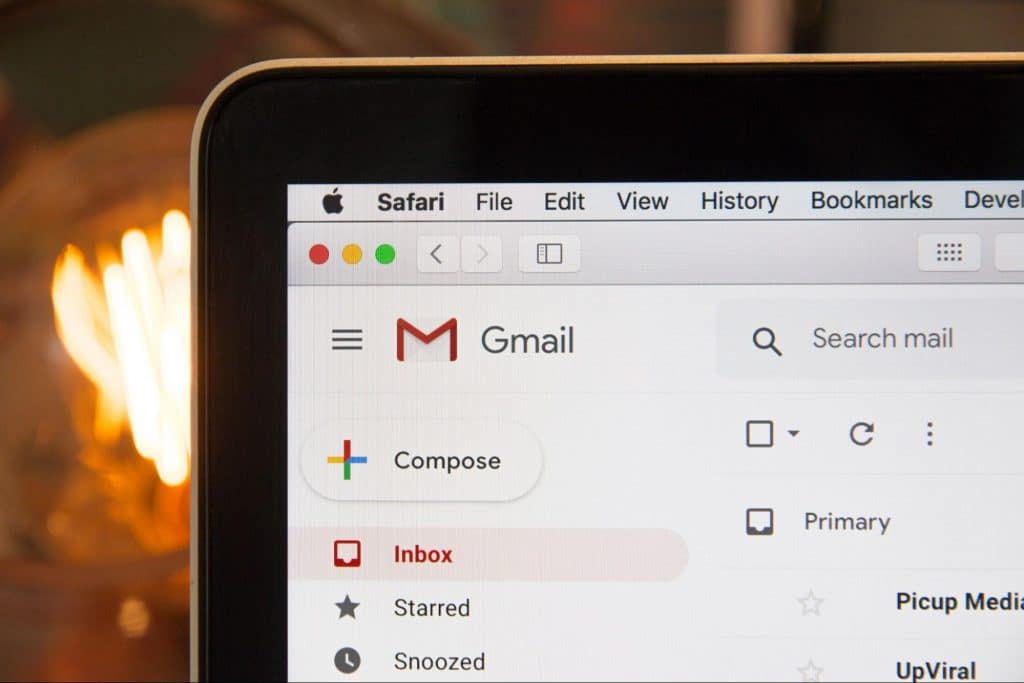
Getting new customers through cold outreach is tough.
Outbound sales techniques like content marketing and SEO might deliver good ROI, but they can take months to be effective.
Employing a sales team to hit the phones and drum up business will get results faster—but the costs of setting this up can be astronomical.
That’s why email marketing is still a surprisingly popular cold outreach strategy. The overheads are relatively low and you can start building direct relationships with interested customers fast.
Not only that, but it works. The ROI for cold email outreach is $36 for every $1 spent.
Enticing email copy is critical to the success of cold email outreach campaigns. If your message doesn’t stand out from the hundreds of other emails and compel them to take action, then recipients will hit ‘delete’.
This blog post:
✔️ Explains the basics of cold outreach email
✔️ Provides tips on writing great emails
✔️ Explains how incorporating personalized images can grab your prospects’ attention
✔️ Provides 7 copywriting frameworks (with examples!)
🚀 Get 60 more free cold outreach email examples!
This guide contains five cold email outreach frameworks and an example of each.
Want to see more?
We’ve created a downloadable resource with 15 frameworks and 70 examples to inspire your cold email campaigns.
What Is Cold Email Outreach?

Cold outreach is when you target sales and marketing campaigns at customers with no prior knowledge of your brand, product, or business.
As described in our intro, these cold outreach campaigns can be delivered over a range of channels. Email is a great option because you can instantly send cold outreach emails directly to a huge number of prospects.
Each cold email outreach campaign consists of six main stages
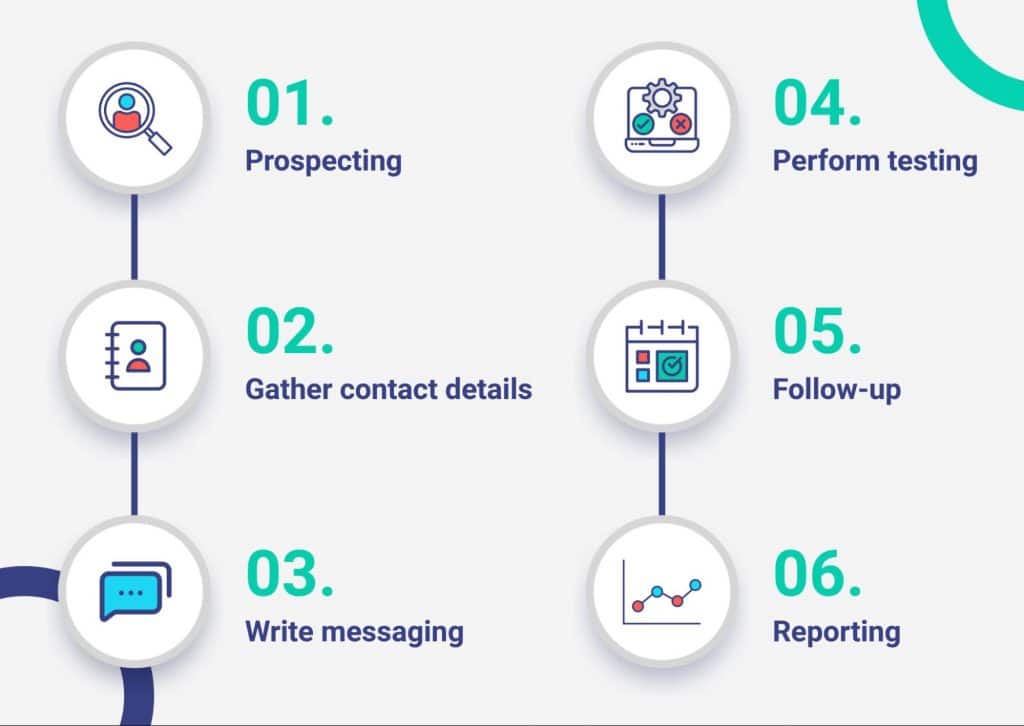
1. Prospecting
This is when you choose which industries and companies you want to target.
To do this, it’s important to have highly specific ideal customer profiles so you target the right people.
💡What is an ideal customer profile (ICP)?
An ICP is a series of characteristics that reflects the best customer a business can have. It includes information about who they are, what they like, and how they behave. By knowing this, a business can focus on finding and keeping customers who are a great fit and likely to buy more from them.
For example, you may specialize in providing accountancy services to those who work in the manufacturing sector. However, you wouldn’t want to email just anyone in the manufacturing sector.
The ideal person would be a decision-maker who is involved in the company’s finances. The chief financial officer would be the ideal person to send a cold outreach email to.
2. Gather contact details
Next up, you need to gather the email addresses of individuals at target companies.
There are three ways to do this:
- Manually find email addresses yourself: This is very time-consuming. It’s also hard because most executives don’t share their contact details online. The big benefit is that it forces you to research the individual, which is something that can be useful later on for creating personalized email content.
- Buy a list of contacts: This is a good way to instantly get hundreds or even thousands of contacts. However, they can be unreliable, depending on where you get them from. Also, because companies move and people leave jobs, your list will soon need an update.
- Use a prospecting tool: Tools like Hunter.io scrape the internet for email addresses and add them to your mailing list. It’s like finding email addresses yourself, except AI does it for you, and it’s fast.
3. Perfect your messaging
This is the most important part where you’ll aim to engage the prospect and encourage them to take action. We’ll go into detail in the next section, but the most important elements of good email marketing messaging are:
- A compelling subject line
- Clear, succinct email body copy
- A clear call to action at the end
- Use personalization elements throughout
4. Perform testing
Sending an email with broken links or other problems is a waste of time and will damage your reputation. Testing ensures your email is perfect before you send it.
Emails tend to look different on different web browsers and email servers. You should check what your email looks like on a variety of different devices and platforms before you hit send.
Testing isn’t just something that happens before you send. A/B testing, for example, involves sending two different versions of an email and tracking which one performs better. This allows you to hone in on what your target audience finds compelling.
5. Follow-up
If you send an email to someone and they don’t respond, then you’ll follow up to remind them, right? It’s the same with cold email outreach.
Sending a polite reminder a few days after you’ve sent your outreach email:
- Shows you are serious
- Shows you care about them responding
- Reminds them to respond (they may have simply been too busy!)
- Prompts them to tell you if they are not interested
Only send one reminder email. If they don’t respond to that, assume they are not interested and take them off your mailing list.
6. Reporting
Analyzing the stats once your campaign is complete is critical. This information will help you plan your next campaign.
Some of the stats you may wish to measure include:
- Unsubscribe rate: What percentage of subscribers chose to unsubscribe during your campaign? The average unsubscribe rate is 0.17%. If yours is higher or lower than this, it’s important to try and understand why.
- Bounce rate: The percentage of messages that get rejected by the receiving email server. This usually happens because the email address was disconnected—for example, because someone left their job. But it could also be because the email address was incorrectly formulated. The opposite of this is the deliverability rate.
- Reported as spam rate: This is the really nasty one you need to avoid—it’s the percentage of recipients who flagged your email as spam. Get flagged as spam too many times and you’ll get blacklisted by the email server. In turn, this means that all your messages will go straight to everyone’s spam folder.
- Open rate: Simply the number of emails opened divided by the number sent.
- Clickthrough rate: This is the number of people who follow your call to action after having opened your email.
- Leads/conversions generated: This is the number of recipients who go beyond clicking your call to action and actually express an interest in or buy your product.
As mentioned earlier, this blog post focuses on messaging because it’s a critical stage that could make or break your campaign.
With that in mind, let’s take a look at some tips for crafting great emails.
7 Cold Outreach Tips
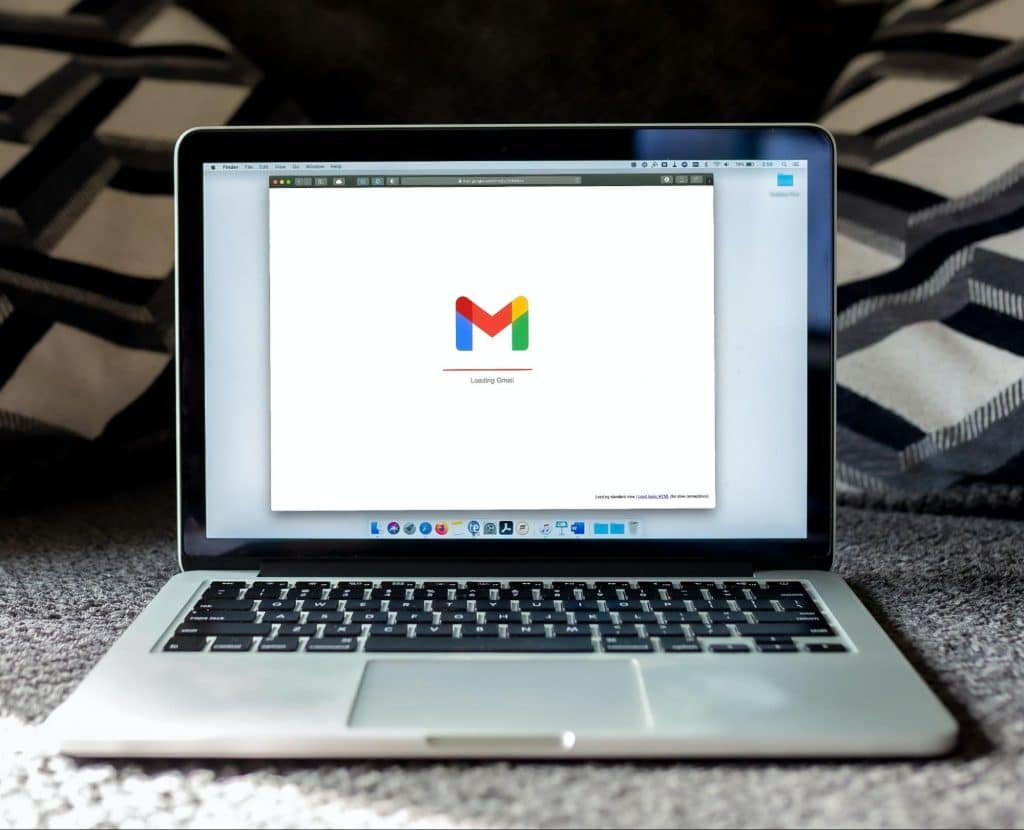
One of the reasons that messaging is such an important stage, is because each recipient is likely being targeted by hundreds or even thousands of email campaigns, all vying for their attention.
Most of them aren’t interesting and feature generic messaging, so people’s first reaction is to delete them—even if they haven’t read them.
According to Quickmail, the average open rate for cold email outreach campaigns is 44%, but the average click-through rate (that’s how many people follow the link at the end of your email) is just 3.67%.
This means getting recipients to open, read, and then click through from your cold email is no easy task. Your message needs to be better than everyone else’s.
Let’s look at some of the ways you can do this:
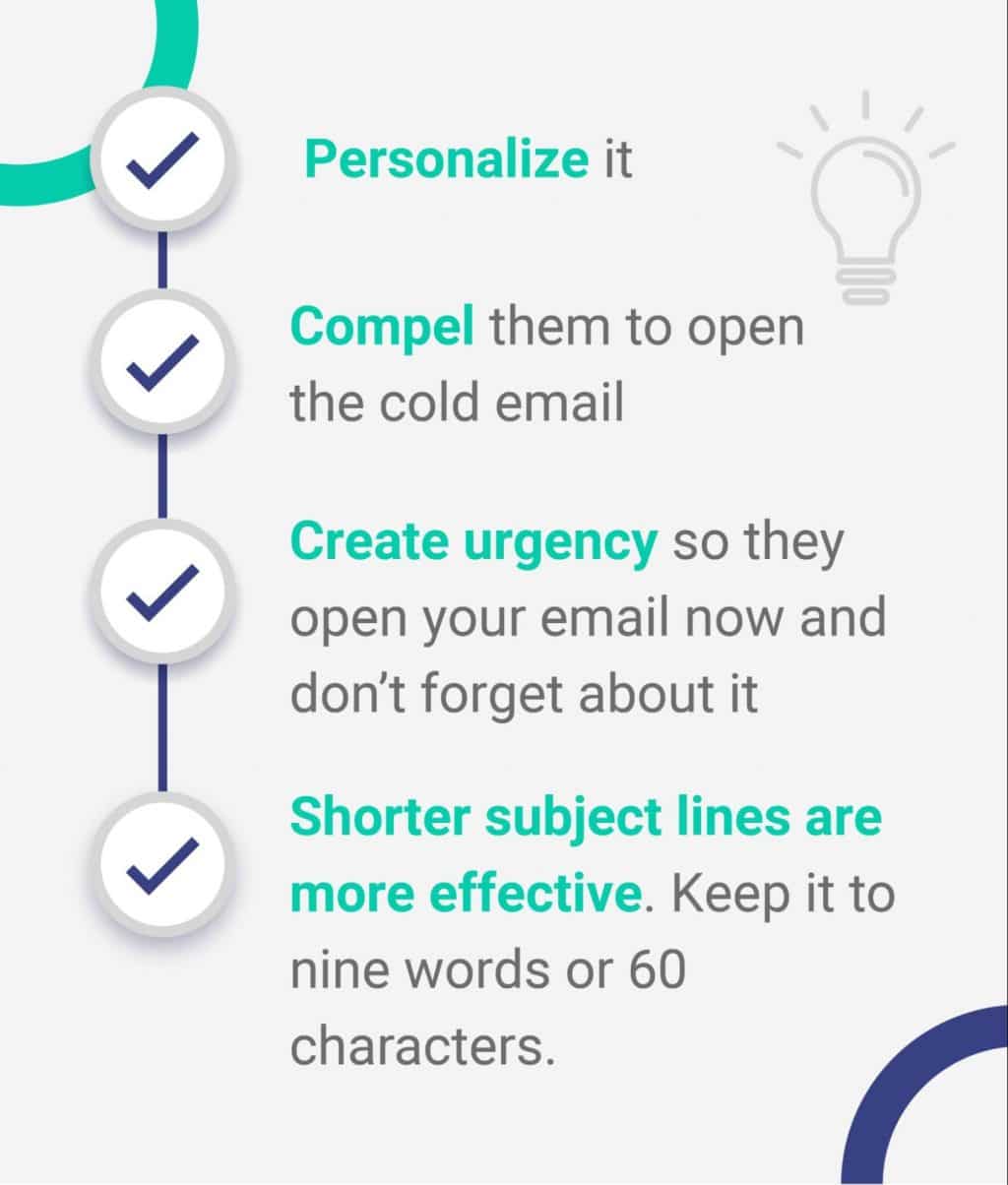
1. Write a compelling subject line
A good subject line can make or break your email campaign. 64% of cold email recipients decide whether to open an email based on the subject line. But, 69% will also decide to report an email as spam based on the subject line.
Here are a few tips for good cold email subject lines:
📧 Personalize it
📧 Compel them to open the cold email
📧 Create urgency so they open your email now and don’t forget about it
📧 Shorter subject lines are more effective. Keep it to nine words or 60 characters
A good example that incorporates these tips, is:
“Boost [your website’s] traffic by 50% – free limited offer!”
2. Keep it short and simple
Someone who has never heard of your company isn’t going to spend hours reading your email. In fact, the average person spends just nine seconds reading a marketing email.
This means you’ve got to hook them and deliver your message as quickly as possible. Try to communicate your message in 125 words, certainly no more than 200.
Avoid using jargon and anything else that makes your message harder to read and understand.
3. Be clear
Don’t expect recipients to read between the lines. Instead, be clear and precise about why you are cold emailing them and what you want them to do.
For example:
Hi, I’m John from [company],
We provide [X].
We’ve helped companies like yours achieve [stats, link to case study].
I think we could help you achieve similar results, which is why I’m offering you a special introductory rate of [$$].
To take advantage of this opportunity, respond to this email by the end of this week.
Kind regards
John
4. Highlight pain points
Highlighting customer pain points shows that you understand the problems they face. It also reminds them that they need to solve these problems, which encourages them to take action.
For example:
“Do you struggle to recruit good people? Is your business less productive due to a lack of skilled workers?
My company M-Recruit has a unique system for finding high-quality candidates. I’d love to book a call to learn about your challenges and how we can solve them.”
5. Provide value
You’ve just emailed someone out of the blue and asked them to do something. So why should they trust you? One effective way to gain trust and get the prospect to engage with your email is by offering them something of value.
This could be a research report that you have published or even just an interesting fact about their industry that they might not have known.
For example:
“Our research reveals 89% of accountancy customers prefer to buy services online—you can read the full report here.”
6. Use proof
One of the best ways to pique the prospect’s interest and gain their trust is by showing what you have done for others in the past. Link to case studies or share results from your previous successes.
“We recently helped [company X] increase their marketing ROI by 52%—read our case study to learn more.”
7. Personalize
If you rely on a generic cold email outreach campaign, people will see it as nothing more than a sales pitch and hit ‘delete’. But if you personalize the campaign, people are more likely to see it as something created especially for them, which will encourage them to open it.
Some basic ways to do this include mentioning people’s names and their company. More advanced techniques involve doing some research on the company. For example:
“I noticed you worked on Borham Telecom’s 5G Readiness project. We have experience in supporting similar work and we’d love to discuss how we can help you.”
However, an even better way to personalize a message and get the reader’s attention is to use animated personalized images.
This works because people’s brains are wired to follow patterns. So, for example, when reading a cold outreach email, we usually think:
- This is a cold email.
- I’m probably not interested.
- Let’s just delete it and move on.
Because our brains seem to follow this pattern, people often automatically delete cold emails without even considering whether they need the service or product.
By using animated images that include some form of personalization, you break these patterns. This is called a pattern interrupt.
Pattern interrupts are useful marketing tools. Not only do they get the reader’s attention, but they also make them stop and take your offer seriously.

Personalization case study: HubStaff
If you want to use personalized images in your cold email outreach campaigns, then try Hyperise. It’s an image personalization toolkit that helps salespeople and marketers to get their prospects’ attention.
For example, remote team management software provider HubStaff recently used Hyperise to increase the click-through rate (CTR) of its cold email campaigns by around 3.5x.
It did this by sending each recipient a personalized images that showed the prospect’s face embedded in a product screenshot.

This had two effects on the recipient:
- It got their attention because they saw their own face in the image.
- It allowed them to visualize the product in action.
This increased the CTR on opened emails from 3% to 11%. Further personalization on the campaign landing page also led to conversions doubling.

The overall result was a staggering 7x increase in sign-ups!
Sign up for a free trial of Hyperise and see for yourself how it boosts click-through rates and engagement.
Why creating personalized, compelling campaigns is critical
If no one opens your email, you’ve wasted time and money with your campaign. Plus, you’ve missed out on potential revenue.
You could also get blacklisted by email servers—this means all of your future cold email campaigns would go straight to people’s spam folders.
Why would this happen? Because spam filters use signals to detect whether a message is spam or not.
Signals that a message is spam include:
- It is marked as spam
- It is deleted
- It isn’t opened
- It has a high bounce rate
In other words, if people react negatively to your message, the email server may eventually decide your message is spam.
Once this happens, it becomes almost impossible to get your emails read.
Nearly 20% of all emails get caught by spam filters, so this is a very real threat.
💡 Top tip: Put yourself in your audience’s position
One of the best ways to write an effective cold outreach email is to put yourself in your audience’s position.
Ask yourself things like:
- What information would make you open, read, and trust an email from someone you’d never met before?
- How familiar are they with the problems you solve and the types of solutions you offer?
- Do you need to explain any concepts or technical terms?
- Is it likely someone has already provided your service to them? How will that affect your messaging?
- What assumptions am I making about the reader that might put them off engaging with my email?
Master the Art of Cold Outreach Copy in 2023 with These 7 Powerful Frameworks
There are many tried and true frameworks for writing cold outreach emails. This section lists seven, but there are many more.
If you want more, then download our comprehensive list of 15 frameworks with over 75 examples.
1. AIDA: Attention, Interest, Desire, Action
The AIDA (Attention, Interest, Desire, Action) framework has proven effective in various types of marketing communications, including cold outreach.
It focuses on creating a persuasive, engaging message that captures your prospect’s attention. The aim is to guide the prospect through the decision-making process and encourage them to take action.
Here’s a more detailed breakdown of how to use the AIDA framework in your cold outreach:
Attention: Start with a compelling subject line. Use intrigue, personalization, or an enticing offer to pique the reader’s curiosity and ensure your cold email stands out in their inbox. Doing so means the recipient will be more likely to open and read your email.
💡 Subject line example: “Unlock Your True Potential: Exclusive Offer Inside”
Interest: Once you’ve captured the prospect’s attention with a captivating subject line, it’s time to generate interest in your product or service. Provide relevant information, share interesting facts or statistics, and highlight the unique features or benefits of your offering. The goal is to create a sense of curiosity and compel the prospect to continue reading.
💡 Example: “Did you know that 90% of top-performing professionals use [Your Product] to streamline their daily tasks and enhance productivity?”
Desire: After you’ve generated interest, invoke desire by helping the prospect visualize the positive outcomes and benefits of using your product or service. Describe how your offering solves problems, improves lives, or helps achieve goals. Use emotional triggers and storytelling to create a strong connection between the prospect and your solution.
💡 Example: “James was struggling to complete his daily tasks. Every day, his workload was getting bigger and he missed critical deadlines. With [your product], he completes these tasks in half the time, freeing up his schedule to focus on more important aspects of his life and career. With [Your Product], this can become your reality too.”
Action: Finally, prompt the prospect to take action. This can be signing up for a free trial, scheduling a consultation, or making a purchase. Be clear and concise in your call to action (CTA), and create a sense of urgency to motivate the prospect to act immediately.💡Example: “Don’t miss out on the opportunity to supercharge your productivity. Sign up for a 30-day free trial of [Your Product] today and experience the difference for yourself!”
Personalization: Remember to personalize your copy and consider incorporating visual elements to enhance the impact of your message and improve your chances of success.
Use personalized images to create interest, such as a screenshot of the prospect’s website with a suggestion for improvement. Invoke desire by highlighting the benefits of your product or service and end with a clear call to action.
AIDA cold email outreach example
To:
Subject: Unleash Your Creativity with Our [Art Supplies Subscription Box]
Hi [Prospect’s Name],
[Attention:] Are you an aspiring artist looking to explore new mediums and techniques?
[Interest:] Our [Art Supplies Subscription Box] delivers a curated selection of high-quality art supplies to your doorstep each month, along with step-by-step tutorials and inspiration.
[Desire:] Imagine the thrill of experimenting with new materials and honing your artistic skills while creating stunning masterpieces to share with your friends and family.
[Action:] Subscribe to [Art Supplies Subscription Box] today and receive a 15% discount on your first box–start your creative journey now!
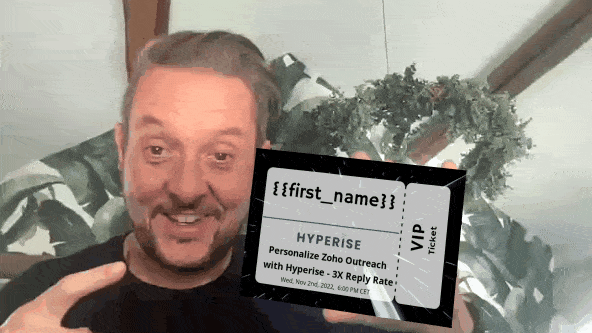
2. PAS: Problem, Agitate, Solution
The PAS (Problem-Agitate-Solve) framework allows you to resonate with your target audience by addressing their pain points. Here’s a more detailed breakdown of the PAS framework:
Problem: Begin by identifying a common problem or challenge your prospect faces. This requires understanding your target audience and empathizing with their struggles. By starting with the problem, you immediately capture the prospect’s attention and create a sense of relatability.
💡Example: “Are you struggling to generate leads for your business and finding it difficult to grow your customer base?”
Agitate: Agitate the problem by highlighting the consequences or negative impact of not solving it. This helps create urgency and emphasizes the importance of addressing the issue.
💡Example: “Without a steady stream of leads, you risk stagnating growth, losing market share to competitors, and potentially jeopardizing the long-term success of your business.”
Solve: Position your solution as the best solution for the prospect’s pain points. To demonstrate how your product or service can effectively alleviate the problem and improve the prospect’s situation, focus on its unique benefits and advantages.
💡Example: “Our cutting-edge lead generation software is designed to streamline your marketing efforts, attract high-quality leads, and ultimately fuel the growth of your business. With features like advanced targeting, automation, and in-depth analytics, our solution empowers you to take control of your lead generation and drive long-term success.”
When using the PAS framework, it’s essential to tailor your message to the specific needs and concerns of your target audience. Doing so creates a connection with your prospects, and demonstrates you understand their pain points and have a solution to address them.
Personalized images can make the problem more tangible, such as a chart showing the prospect’s current metrics compared to those of their competitors.
PAS cold email outreach example
To:
Subject: Say Goodbye to Your Sleepless Nights
Hi [Prospect’s Name],
[Problem:] Are you tired of tossing and turning in bed, struggling to get a restful night’s sleep?
[Agitate:] A lack of quality sleep can lead to chronic fatigue, difficulty concentrating, and even weaken your immune system, putting your overall health and well-being at risk.
[Solution:] Our [Sleep Aid Product] is specifically designed to help you fall asleep faster, stay asleep longer, and wake up feeling refreshed and rejuvenated. Try [Sleep Aid Product] today and rediscover the benefits of a good night’s sleep!
3. Before, After, Bridge (BAB)
The BAB framework is a powerful storytelling technique that showcases the transformative effects of your product or service.
This approach helps prospects visualize the benefits of your solution and builds a strong emotional connection.
Here’s an expanded breakdown of the BAB framework and how to use personalized images effectively:
Before: Begin by describing the prospect’s current situation, focusing on their pain points, struggles, or challenges. This helps create empathy and shows you understand their needs and concerns.
💡Example: “As a small business owner, you’re likely overwhelmed with managing day-to-day tasks, juggling multiple responsibilities, and struggling to find the time to focus on growing your business.”
After: Next, present a vivid picture of the prospect’s situation after using your product or service, highlighting the positive changes, improvements, and overall benefits. This helps create desire and it showcases the value of your offering.
💡Example: “Imagine a world where you can effortlessly delegate tasks, streamline your operations, and dedicate more time to strategic planning and business growth.”
Bridge: The bridge connects these before and after scenarios, and illustrates how your product or service facilitates the transformation. Explain the features, advantages, and unique selling points of your offering to demonstrate its effectiveness in addressing the prospect’s pain points.
💡Example: “Our [Business Management Software] is designed to revolutionize the way you run your business, offering powerful tools for task management, team collaboration, and process automation that will help you reclaim your time and drive success.”
Using personalized images can significantly enhance the impact of your BAB copy by illustrating the contrast between the before and after states.
For example, you could include images that directly compare the before and after scenarios, such as a cluttered workspace versus an organized one, or a low-performing marketing campaign compared to a high-performing one. This visual contrast emphasizes the transformative power of your product or service.
By combining the power of the BAB framework with personalized images, you can create persuasive and engaging copy that effectively demonstrates the value of your solution and compels prospects to take action.
BAB cold email outreach example
To:
Subject: Transform Your Sales Pipeline with [Product Name]
Hi [Prospect’s Name], are you finding it difficult to manage your leads and close deals?
[Before:] You’re struggling with a cluttered sales pipeline, losing track of leads, and missing out on valuable opportunities.
[After:] Your sales process is streamlined and efficient, with increased conversion rates and revenue growth.
[Bridge:] Our CRM solution, [Product Name], can help you achieve this transformation. Schedule a free demo and discover how [Product Name] can revolutionize your sales process!
4. Qualify, Understand, Educate, Stimulate, Transition (QUEST)
The QUEST framework enables you to demonstrate a deep understanding of your prospect’s needs, showcase the value of your solution, and encourage them to take action.
Here’s an expanded breakdown of the QUEST framework and how it can be used with personalized images:
Qualify: Start by qualifying the prospect to ensure they’re a good fit for your product or service. This helps establish relevance and demonstrates that your message is tailored specifically to them.
💡Example: “As a marketing manager for a growing e-commerce business, you understand the importance of reaching the right audience with targeted advertising.”
Understand: Demonstrate understanding by addressing the prospect’s specific needs, challenges, or pain points. This helps build rapport and shows you’ve taken time to research their business and empathize with their situation.
💡Example: “You likely struggle with finding the optimal marketing channels, allocating your budget efficiently, and tracking the ROI of your campaigns.”
Educate: Teach the prospect about your solution by explaining its features, advantages, and unique selling points. Focus on how your product or service can address their specific needs and solve their challenges.
💡Example: “Our [Marketing Analytics Platform] provides comprehensive insights into your campaigns, helping you identify the most effective channels, allocate resources intelligently, and optimize your marketing efforts for maximum ROI.”
Stimulate: Stimulate interest by showcasing the benefits of your solution, emphasizing the positive outcomes, and highlighting any strategic differences that set you apart from the competition.
💡Example: “By leveraging the power of [Marketing Analytics Platform], you can boost your conversion rates, reduce customer acquisition costs, and drive sustainable growth for your e-commerce business.”
Transition: Finally, transition to a call to action (CTA) that prompts the prospect to take the next step, whether it’s signing up for a free trial, scheduling a demo, or making a purchase.
💡Example: “Unlock your marketing potential with [Marketing Analytics Platform]. Schedule a demo today and experience the transformative power of data-driven marketing.”
Incorporating personalized images within your QUEST copy can further enhance its effectiveness by showing the prospect that you understand their business and have taken the time to tailor your message.
Consider the following visual strategies:
- Prospect’s logo on a mock-up: Include the prospect’s logo on a mock-up of your solution, such as a dashboard or report, to create a visual representation of how your product or service integrates with their brand.
- Customized case studies: Present images from case studies that feature similar clients or industries, which will demonstrate the success your solution has achieved for others with comparable needs and challenges.
- Personalized graphs or charts: Use graphs or charts that display data relevant to the prospect’s industry or specific pain points to highlight the measurable impact your solution can have on their business.
By combining the QUEST framework with personalized images, you can demonstrate your understanding of the prospect’s needs and showcase the value of your solution. This ultimately compels them to take action.
QUEST cold email outreach example
To:
Subject: Maximize Your Manufacturing Efficiency with [Software Name]
Hi [Prospect’s Name], are you a manufacturing business owner looking to optimize your production processes? We understand the challenges you face in managing resources, reducing waste, and meeting tight deadlines. Our software, [Software Name], is specifically designed to help manufacturers like you streamline operations and increase efficiency. Explore the benefits and features of [Software Name] that have helped similar businesses achieve remarkable results. Don’t miss out on the opportunity to revolutionize your manufacturing process—request a free demo today!
5. ACCA: Awareness, Comprehension, Conviction, Action
ACCA focuses on raising awareness about a problem or opportunity. It helps the prospect comprehend the situation and your solution, which makes them confident in your product or service, and prompts action.
Personalized images—such as an infographic showing industry trends relevant to the prospect’s business—can help create awareness and aid comprehension.
ACCA cold email outreach example
To:
Subject: Are You Aware of the Power of AI in Marketing?
Hi [Prospect’s Name], did you know that artificial intelligence (AI) can revolutionize your marketing strategy? By leveraging AI-driven marketing tools, you can better understand your audience, create personalized campaigns, and optimize your marketing efforts. We’re confident that our AI-powered marketing platform, [Platform Name], can deliver outstanding results for businesses like yours. Don’t miss out on the benefits of AI in marketing—start your free trial of [Platform Name] today!
6. OATH: Oblivious, Apathetic, Thinking, Hurting
Using the OATH framework involves targeting prospects based on their level of awareness of the problem: oblivious, apathetic, thinking, or hurting.
The aim is to craft a message that connects with their current state. For example, you might send a case study to prospects who are hurting and actively seeking a solution.
The example below might work well for prospects at the thinking stage. If they were more apathetic, you might choose to include some stats on the amount of money businesses lose to data breaches.
OATH cold email outreach example:
Subject: Your Obligation to Data Security – Try [Security Software] Today
Hi [Prospect’s Name],
As a business owner, you have an obligation to protect your company’s sensitive data from cyberthreats.
Take action now by implementing our cutting-edge security software, [Security Software], to safeguard your valuable information.
Trust in our proven track record of helping businesses like yours stay secure.
Give your business the protection it deserves and hope for a safer future—start your free trial of [Security Software] today!
7. 4PS: Promise, Picture, Proof, Push
The 4Ps framework involves making a promise, describing the outcome, providing proof through testimonials or case studies, and pushing the prospect to take action.
Use personalized images to help paint a picture of the outcome and provide proof. For example, you could send your prospect a testimonial from a similar client with their headshot or a graph that shows the improvements achieved by your existing clients.
4Ps Email Example 1:
To:
Subject: Achieve Flawless Skin with Our Revolutionary [Skincare Product]
Hi [Name],
[Promise:] Imagine having clear, radiant, and youthful-looking skin every day with the help of our groundbreaking [Skincare Product].
[Picture:] Envision yourself waking up each morning, looking in the mirror, and being amazed at the visible improvements in your skin’s texture and appearance. Your confidence soars as you step out into the world, glowing with health and vitality.
[Proof:] Thousands of satisfied customers have experienced incredible results, and we have numerous testimonials and before-and-after photos to back up our claims. Our [Skincare Product] is also backed by scientific research and has been dermatologically tested for safety and efficacy.
[Push:] Don’t miss out on the opportunity to transform your skin and boost your self-confidence. Try [Skincare Product] today and experience the difference for yourself. Order now and get a special 20% discount on your first purchase!
How to Choose a Framework
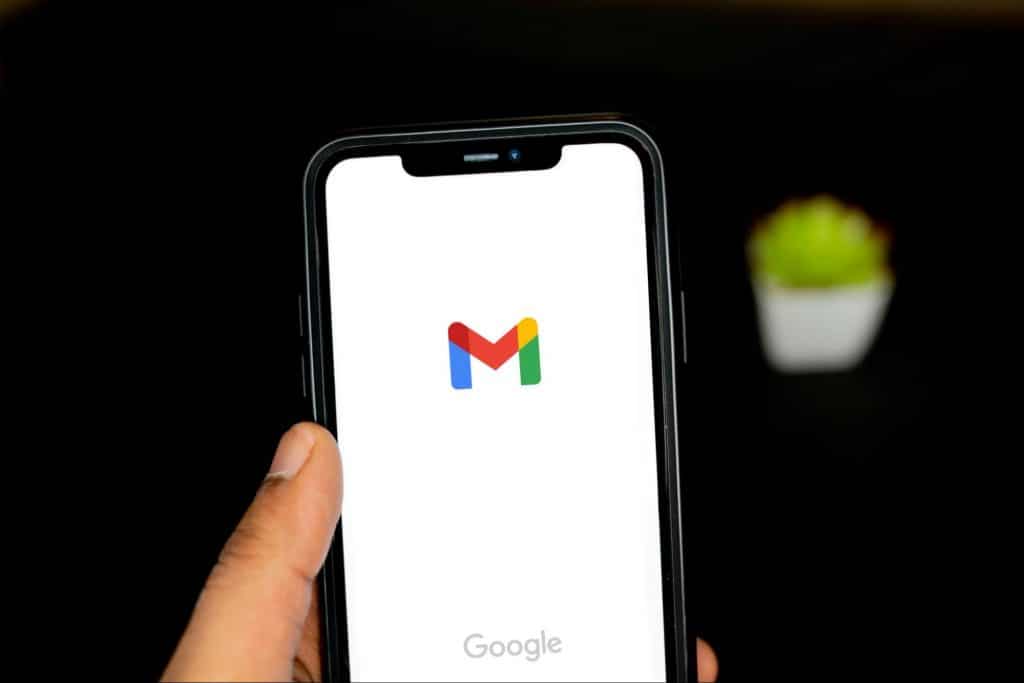
Mastering the art of cold outreach copy involves choosing the right framework and incorporating personalized images to grab attention and trigger pattern interrupts.
Each copywriting framework has its own unique strengths and can be effective for different industries.
To help you choose the best framework for your specific needs, listed below are some recommendations based on various industries. Please note, not all of these are mentioned in this article. Check out our complete list of 15 frameworks to find out about them.
🛒 e-Commerce and retail: The AIDA and 4Ps frameworks work well for these industries, as they entail grabbing attention, generating interest, and motivating customers to take action.
💻 Software and technology: The FAB and UPWORDS frameworks are suitable for tech companies, as they focus on highlighting the features, advantages, benefits, and the urgency of adopting new technology.
🤾♀️ Fitness and wellness: The 3Ps and KISS frameworks can be effective in the fitness and wellness industries, as they address pain points, promise improvement, and highlight the pleasure of reaching goals, while keeping the message simple and concise.
🎓 Education and training: The PASTOR and 4Cs frameworks are ideal for educational and training services, as they rely on storytelling, testimonials, and the credibility of the offer, while ensuring a clear, concise, and compelling message.
🎨 Creative and design: The SOFT and FAB frameworks work well for creative and design services, as they focus on simplicity, originality, and the tension between the problem and solution, as well as the features, advantages, and benefits of the service.
👨💼 Consulting and professional services: The 4Us and 3Ps frameworks are suitable for this industry, as they highlight unique aspects, ultra-specific details, usefulness, and the urgency of obtaining the services, while addressing pain points and providing promises of improvement.
Conclusion: Testing Your Idea Is Key
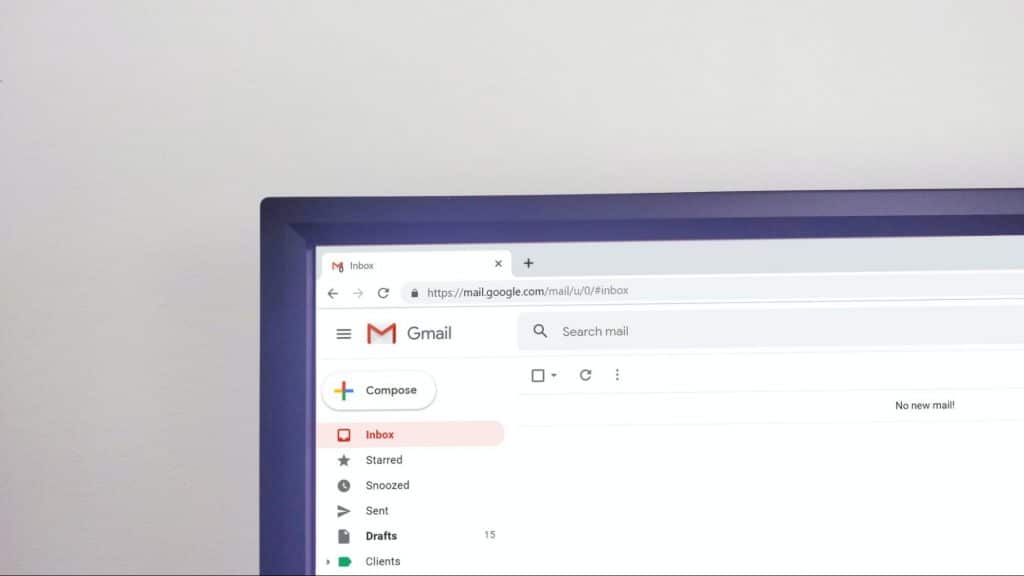
Ultimately, the best framework for your cold outreach copy will depend on your industry, target audience, and the specific goals of your campaign.
It is essential to experiment with different frameworks, personalize your messages, and incorporate visual elements to enhance the effectiveness of your cold outreach.
By doing so, you can create compelling copy that resonates with your audience and achieves your desired results.
To discover how integrating personalized images with your cold outreach can boost engagement and click-through rates, request a free trial of Hyperise today.
Cold Email Outreach FAQs
Is cold email outreach legal?
Yes, cold email outreach is perfectly legal as long as you follow regulatory guidelines, such as:
Controlling the Assault of Non-Solicited Pornography And Marketing (CAN-SPAM)
This is a U.S. federal law that regulates commercial email messages. It establishes rules and requirements for email marketers to ensure transparency, accuracy, and recipient opt-out options. If you market to U.S. prospects, then you need to adhere to it.
CAN-SPAM mainly focuses on email marketing messages. It does not cover other electronic messages or the management of people’s personal data.
The Federal Trade Commission published a guide to help businesses comply with the act.
Canadian Anti-Spam Legislation (CASL)
This law imposes strict consent and identification requirements. Under the law, email marketers must obtain explicit consent and provide clear identification in their email campaigns when they target Canadian recipients.
CASL applies to a wide range of electronic marketing messages, not just emails.
Here is a guide to complying with CASL from email marketing giant Mailchimp.
General Data Protection Regulations (GDPR)
Like CAN-SPAM and CASL, GDPR establishes rules for consent and identification requirements. However, it applies to a much wider range of marketing messages and also sets out rules for managing, storing, and acquiring people’s data.
Here’s a good guide to complying with GDPR for email marketers.
How do I send a cold outreach email?
Technically, all you need to send a cold outreach email is an email address and a list of email addresses to send your message to.
However, if you have the budget available, it is usually better to use email marketing software. Popular examples include Mailchimp, Campaign Monitor, and SendX.
These systems come loaded with tools that make it easier to send, track, and respond to thousands of emails.
It’s also important to ensure that the people on your mailing list match your ideal customer profiles. Doing so will increase your open rates and generate better ROI.
When is the best time to send a cold outreach email?
There are many research findings that indicate the best time to send sales and marketing emails—and most of them report different results!
In general, the best time to send cold emails is 8 a.m. – 3 p.m. on Tuesdays.
However, this varies depending on your target audience, sector, and what action you want recipients to take. You should always research your ideal customers before you start planning your cold email campaign.
Last Updated on February 9, 2024 by Ian Naylor